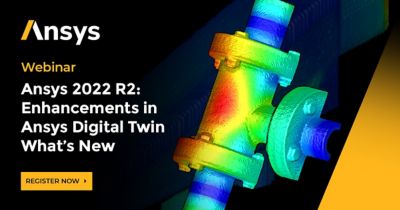-
-
Kostenlose Software für Studierende
Ansys unterstützt die nächste Generation von Ingenieur*innen
Studenten erhalten kostenlosen Zugang zu erstklassiger Simulationssoftware.
-
Verbinden Sie sich jetzt mit Ansys!
Gestalten Sie Ihre Zukunft
Stellen Sie eine Verbindung mit Ansys her, um zu erfahren, wie Simulation Ihren nächsten Durchbruch vorantreiben kann.
Länder und Regionen
Kostenlose Demoversionen
Produkte & Dienstleistungen
Lernportal
Über das Unternehmen
Back
Produkte & Dienstleistungen
Back
Lernportal
Ansys unterstützt die nächste Generation von Ingenieur*innen
Studenten erhalten kostenlosen Zugang zu erstklassiger Simulationssoftware.
Back
Über das Unternehmen
Gestalten Sie Ihre Zukunft
Stellen Sie eine Verbindung mit Ansys her, um zu erfahren, wie Simulation Ihren nächsten Durchbruch vorantreiben kann.
Kostenlose Demoversionen
ANSYS BLOG
September 8, 2022
Ansys 2022 R2 Introduces Fusion Modeling, a new Capability to Ansys Digital Twin Hybrid Analytics
From the automotive and high-tech industries to industrial equipment and energy, our digital twin solution helps you track the past, provide deeper insights into the present, and predict and influence future behaviors of your products.
With our new release of Ansys Twin Builder, we continue to provide you with the right technology for accurate and evolving digital twins with Twin Builder Hybrid Analytics and its new Fusion Modeling capability.
Ansys Twin Builder Hybrid Analytics combines machine learning (ML)-based analytics with a physics-based approach to create the best possible digital twins and increase digital twin accuracy up to 98%.
New capabilities in our latest release include powerful features in Twin Deployer, more accurate error prediction of your reduced order model (ROM), the Toshiba ACCU-ROM Tool Kit, several enhancements to the Modelica UI, and access to Twin Builder in PyAnsys.
Let’s take a look at the top key enhancements in the latest release of Twin Builder that continue to transform your operations with hybrid digital twins.
Increase Digital Twins Prediction Accuracy with Ansys Twin Builder Hybrid Analytics
The Hybrid Analytics Fusion Modeling capability, introduced in Ansys 2022 R2, enables you to accurately model the residual between model and prediction. The Fusion Modeling capability bridges the gap between real-life asset behavior and digital twin prediction by building a fusion model. You can now capture and include any remaining or missing physics into the digital twin, increasing the accuracy of your digital twin up to 98% or more, by combining the best of artificial intelligence (AI) and physics.
Several enhancements to the Twin Deployer enable easier deployment workflow and improve the re-compilation workflow with Modelica libraries on Linux. The back-end and front-end design changes improve user experience for twin deployment. With the help of new application programming interfaces (APIs) for container deployment, you can set the customized initial parameters and visualize ROM images in deployment. With this new release, you can now run deployment on Ubuntu 20.04 OS.
More Accurate Reduced Order Models (ROM)
With our new release, new cool features have been added for powerful enhancements in ROM building process to predict the accuracy of the ROMs, visualize and compare 3D fields, and get a better visualization of your reduced-order model.
- Error Prediction in Static ROM Builder: You can now predict the accuracy of ROMs during the build process with absolute and relative error estimates. The output pins of predicted errors can be used to monitor errors during the operation of your ROM.
- Cut-plane Coordinate Specification on Normal Plane: You can accurately define cut-planes with coordinates for better visualization. You can now define cut-plane specification in Static ROM builder, Dynamic ROM Builder, and ROM viewer and combine multiple cut-planes.
- Comparison of fields in Dynamic ROM Builder: You can visualize and compare 3D fields when building dynamic ROMs with reference snapshot field for error calculation.
Enhanced Solver, Model Library, and User Experience
As part of the new release, the Toshiba ACCU-ROMTM Tool Kit is available in Twin Builder. This tool kit makes easier to design electric power steering (EPS) systems and enables fast simulation for both the electronic circuits and mechanical components. This tool kit is available for download in the Ansys Customer Portal.
“With the increased popularity and complexity of electric vehicles, model-based simulation is critical for evaluating and validating multiple designs,” said Takashi Miyamori, director, Toshiba Electronic Devices & Storage Corporation (Toshiba). “Toshiba, in collaboration with Ansys and its Ansys Twin Builder system simulation technology, has developed a new toolkit for design and validation of automotive electrical systems. The Accu-ROM™ (Accurate Reduced-Order Modeling) Toolkit for System Simulation enables high-precision and high-speed system simulation for both electronic circuits and mechanical components, shortening verification times for automotive semiconductors by about 90%.”
- Enhancements to the Modelica UI: This enables a better user experience.
- Automatic Connector Sizing Support for Modelica Editor: Automatic connector sizing increases the connector size as more connections are made and readjusts as connections are removed.
- Relevant Parameters with Dialog Annotation in Modelica Editor: Support for Dialog Annotation enables you to only show important parameters, simplifying the parameter interface and improve usability.
- Tooltip Support for Connectors in Modelica Editor: Improved usability with new tooltip to identify the size of mixed-size connectors, which is helpful for automatic connector sizing.
- Twin Builder is Now Available in PyAnsys: Automate Twin Builder in Python.
Eager to see our new Twin Builder features in action? View our on-demand webinar: Ansys 2022 R2: What's New in Ansys Digital Twin.
Or request a 30-day Twin Builder free trial to start simulating sooner.
